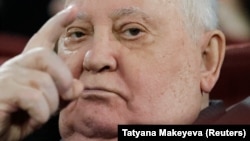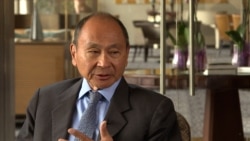Glowing global tributes have been pouring in for Mikhail Gorbachev, who died on August 30 at the age of 91.
As the last Soviet leader, his reforms helped end the Cold War and free Eastern Europe from communism, but also led to the collapse of the Soviet Union.
U.S. political scientist Francis Fukuyama said Gorbachev will be remembered for his "unparalleled" contribution to human freedom, in an interview with Current Time, the Russian-language network run by RFE/RL in cooperation with VOA:
A "trusted and respected leader" is the way European Commission President Ursula von der Leyen described Gorbachev, the Nobel Peace prize winner in 1990.
Gorbachev launched perestroika (restructuring) and glasnost (openness) that transformed Soviet rule, ultimately leading to its collapse and the freeing of its 15 republics.
When pro-democracy protests rocked Soviet-bloc nations in communist Eastern Europe in 1989, Gorbachev refrained from using force, breaking with the legacy of previous Soviet leaders who had sent tanks to crush uprisings in Hungary in 1956 and Czechoslovakia in 1968.
But that was not the case in many of the former Soviet republics, where many people don't remember Gorbachev as an emancipator but more for his efforts, including bloody crackdowns, to keep the Soviet Union intact.
"Lithuanians will not glorify Gorbachev. We will never forget the simple fact that his army murdered civilians to prolong his regime's occupation of our country. His soldiers fired on our unarmed protesters and crushed them under his tanks. That is how we will remember him," said Lithuanian Foreign Minister Gabrielius Landsbergis in a Twitter post.
Gorbachev had refused to accept Lithuania's independence, declared in March 1990, resorting to economic and political pressure to thwart it. When that failed, Soviet troops were sent in to restore "order." At least 14 people were killed and more than 700 wounded in a showdown in the country's capital, Vilnius, in January 1991.
Over the years, Lithuania -- which joined NATO and the European Union in 2004, along with fellow Baltic states Latvia and Estonia -- sought to bring those responsible for the bloodshed to justice. Gorbachev refused to cooperate with the Lithuanian court, declining to testify.
Lithuania was not an isolated case.
In the spring of 1989, Georgians took to the streets to demand independence from the Soviet Union. At the peak of the demonstrations, many thousands of people -- some of them on hunger strike -- gathered in central Tbilisi. On April 9, Soviet Interior Ministry troops moved in to the Georgian capital to crush the peaceful protests, killing at least 20 people and leaving hundreds injured or poisoned by gas.
"Thirty three years since the April 9 Massacre by the Soviet army under #Gorbachev rule, the resistance and bravery which laid the foundation to restoration of Georgia's independence. Instead of glorification, the West should listen to the voices from Tbilisi, Riga, Vilnius, Baku, Almaty," Georgian analyst Katie Shoshiashvili wrote on Twitter.
Three years earlier, in December 1986, students demonstrated in Almaty, Kazakhstan, in what is considered the first public anti-Kremlin protest of Gorbachev's glasnost era.
Inspired by his calls for glasnost and perestroika, the protesters slammed the appointment of an ethnic Russian from outside Kazakhstan to the top post as Communist Party leader. The Zheltoqsan (Kazakh for "December") protests lasted several days and spread to other towns before being suppressed by Soviet security forces in what was dubbed Operation Snowstorm. Unconfirmed reports spoke of more than 100 people being killed and a much higher number being injured during the crackdown.
"How much blood was shed in December of 1986? How many lies were out there? Everything has been revealed now, it was Gorbachev who ordered it and the KGB who masterminded it," said Seidakhmet Quttyqadam, the former Kazakh deputy information minister.
WATCH: In the West, Mikhail Gorbachev is widely regarded as the Soviet leader who helped bring a peaceful end to the Cold War. In the post-Soviet states, however, many view him in a different light. Some within the region hold him responsible for brutal crackdowns during their fight for freedom and independence.
Four years later, Soviet troops again were deployed, this time to Azerbaijan to put down anti-regime protests there. On the night of January 19-20, 1990, the Soviet Army rolled into Baku to try to impose Moscow's will on a restive population. Soviet Defense Minister Dmitry Yazov said the army was attempting to stop a national protest movement from overthrowing the government.
After a night of indiscriminate violence by Soviet troops that left an estimated 133 people dead and 611 injured, Baku's sky that morning was "blood red," 76-year-old Emilie Ragimova told Current Time in 2020 on the 30th anniversary of the crackdown. "And the streets were black: black flags and ribbons everywhere, black clothes on people."
For many in Ukraine, it's not necessarily what Gorbachev did but what he didn't do during the Chernobyl nuclear disaster in April 1986.
A year in power at the time, Gorbachev was faulted for reacting slowly. Although the nuclear accident happened on April 26, Gorbachev did not inform the Soviet people of its full scope until May 14. The Chernobyl disaster and his reaction to the incident also earned Gorbachev an infamous nickname -- "the Stained Leader" -- a reference also to the birthmark on his forehead.
"Gorbachev ordered the closure of all information about the Chernobyl disaster, which had been classified for five years. Of course, the KGB exerted enormous pressure on him. This was Gorbachev's miscalculation and he openly spoke about it. They took people out of Prypyat and did nothing for the surrounding villages from ChErnobyl," said Yuriy Scherbak, Ukraine's first environment minister, referring to the town near the doomed power plant that housed its staff.
"There were children there, but they did not even give iodine and did not conduct iodine prevention. There is a problem in this. It is a crime of that government," Scherbak told RFE/RL's Ukrainian Service.
Inaction was also the barb directed at Gorbachev for his response in 1988, when an enormous earthquake hit Armenia on December 7 of that year, leading to the deaths of more than 25,000 people.
The epicenter of the quake was in the mountain village of Shirokamud, referred to among its inhabitants by its old name Nalband. The village is on the main east-west road between Spitak and the country's second-largest city, Gyumri, known in Soviet times as Leninakan.
Gorbachev cut short a visit to New York, where he had been feted by the press and thousands of cheering Americans, to fly into Soviet Armenia's nightmare.
Sukias Avetisian was a communist youth leader in one of Leninakan's (now Gyumri's) districts in 1988 -- at the time of the quake.
"There was a mixed feeling [about Gorbachev] among the people at that time. On the one hand, there was a need for his strong leadership so that the [Soviet] state could help with equipment to clear the rubble after the earthquake because we were short of equipment to conduct search-and-rescue operations," Avetisian told RFE/RL's Armenian Service. "On the other hand, there was a [conspiracy theory] among people that it was an artificially caused earthquake [to quell the emerging national-liberation movement in Armenia]."
Gorbachev was a "man of his time," who at first wanted "to prevent the collapse of the Soviet Union," explained Belarusian writer, Nobel laureate, and opposition figure Svetlana Alexievich, who first met Gorbachev in 1999 in Paris.
"He did not immediately become the Gorbachev that we remember. He changed over time. I'm not saying that can justify it (the crackdowns and other antidemocratic actions). But even great people are not always equal to events as they are happening," Alexievich told RFE/RL's Belarus Service.
"But we can credit him for making a strong [transformation], which at that time was not possible for anyone else. But he did it."

















